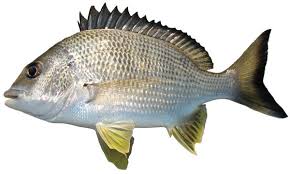By the time the Boyne Tannum Hook Up comes around there should be plenty of bream starting to show up in our estuary waters.
That includes both Yellow Fin Bream and Pikey Bream.
This is the first time that Pikey Bream have been included as a qualifying species for the Boyne Tannum Hook Up. That is an exciting development as Pikey Bream have been well represented as by catches in recent Hook UP’s.
Yellowfin bream (A.australis)

Yellowfin bream have silver to bronze bodies and the lower fins are yellow to white.
Yellowfin bream are well dispersed along our coast line from Townsville to Victoria and they are predominantly found in estuary systems and in close coastal waters including harbors and rocky reefs and coastal saline lakes. The size of bream you find in these locations very much relates to their breeding cycle.
Spawning occurs during winter in sandy beach areas close to estuary systems and the tiny fry (less than 1cm) quickly move up into the estuary systems that will be their home until they reach maturity at about 5 years and reach around 22cm in length.
Maximum size is around 50cm. Once mature all male fish spawn.
The habitats that juvenile bream and mature bream share estuary systems includes natural environments made up of weed beds, the edges of mangrove banks, inundated mangroves, overhanging trees and drowned trees and vegetation, sandy and muddy areas and rocky reefs, shore lines and rock bars and man-made environments including rock walls, bridge pylons, jetties, pontoons and bridges and under moored boats etc.
After spawning not all mature fish return to estuaries and some disperse into close coastal waters including harbors and coastal rock bars and saline lakes, with the bigger fish in particular ranging much further than they did as juveniles, where they favor the same types of habitats they did as juveniles but with a greater emphasis on rocky shores and rocky reefs and rock walls. Older fish prefer deeper water.
Pikey bream (A.Pacificus)

Pikey bream are sometimes mistakenly called black bream which is a completely different southern waters species.
The pikey bream breeding cycle is like yellow fin bream but both juvenile and mature fish favor much rougher muddy/sandy terrain than silver bream and spend a lot of time in deeper water than yellowfin bream.
Maximum size is around 27cm.
Bream is a slow growing species and it doesn’t matter which part of Australia your fishing in, or the actual species of bream your targeting, by the time they reach their minimum legal size which can vary from state to state and time to time they are around 5 or 6 years old. With that in mind I always exercise catch and release when fishing for bream.
Generally, bream are most active when the tide is rising and on the ebb of the rising tide. Keep in mind however that once the tide inundates mangroves bream have a tendency of move deep into the root systems making them hard to target with artificial baits such as flies, lures and soft plastics. Keep in mind that when the tide changes bream have to retreat from the mangroves and for the early part of the falling tide become much easier to target.
- Bream snack throughout the day with bite windows generally triggered when there are concentrations of food and in the hottest part of the day tend to forage deeper and in the cooler part of the days around dusk and down tend to forage more widely depth and terrain wise.
- In the hottest part of summer bream can be particularly active at night when the water is coolest and not only forage over a greater range of depths and but also forage right up into shallower water.
- Juvenile bream tends to be relatively resident for long periods in the same area and only move on if conditions become unfavorable. Bream are both opportunistic feeders and predators in that on the one hand they will foraging around the bottom, in and around structure for tucker yet on the other hand they will take advantage of structure and wait for food to come to them. They eat a wide range of tucker including prawns, shrimp and other crustaceans, crabs, mollusks such as oysters, worms, and vegetation. They generally feed in small group from the same cohort in and around weed beds, drowned timber, man-made structures including bridge pylons, pontoons, and bridges, under moored boats and even on flat open sandy and muddy bottoms searching for food.
Stealth
Keep in mind that bream are easily spooked so you have to be stealthy in your movements and casts.
- So, when you approach an area you going to fish do it slowly and if available quietly under the power of your electric motor and take advantage of any cover that’s available. Do not cast a long shadow over, or motor over, the water you’re going to fish. Longer casts are important and cast to the side of any fish you are targeting.
- If you are using an anchor deploy it upwind & current of the fish and retrieve it slowly and quietly so that there is no bumps or chain noises that will scare fish.
- Part of the stealth equation is fishing as light a leader and tippet as you can get away with flies, lures and soft plastics that have just enough weight or bib action to get those baits down to where bream are holding or feeding.
